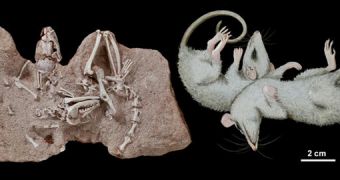Unlike their more modern descendants, early marsupials were living in large social groups, a study of a mass grave containing fossilized remains of early marsupials indicates. The work sheds some more light on the behavior of animals that lived millions of years ago.
The particular creatures that were discovered in the mass grave are no larger than average rats, but they apparently enjoyed each other's company. About 35 individuals were found in a single tomb.
According to investigators, the new research could provide additional insights into the ecology of this species, as well as into how life was set up at the time when they lived in general. Discovering such large caches of bones is a very rare occurrence.
Most of the newly-found skeletons are incomplete to some extent, but they all belong to the ancient marsupial species Pucadelphys andinus, which is an ancestor of new marsupials. The bones were discovered in South America, and represent the most complete collection of this kind ever assembled.
“We found a large number of complete skeletons from marsupial mammals. It's very exceptional. We can have access to how they lived and to their ecology,” explains study researcher Sandrine Ladevèze.
The investigator, who holds an appointment at the Royal Belgian Institute of Natural Sciences,” says that the creatures are similar to opossums in appearance. The individuals that were entombed in the same place were probably surprised inside their homes by a flash flood or similar event.
“In extant marsupials, it's something very unusual to have so many individuals together,. They are very territorial and live in isolated areas,” explains Ladevèze, as quoted by LiveScience. The new cache includes 6 males, 12 females and 5 youngsters.
“We have a population with social interaction, both between males and females and between the old and young,” Ladevèze adds. He explains that marsupials probably appeared less than 125 million years ago, during the Cretaceous.
This period spanned from 144 to 65 million years ago. Between those dates, most marsupial species, including the kangaroos of Australia, derived from a common ancestor. It could be that Pucadelphys andinus was the first species of its kind to make its way into South America.
This may help explain why these rodents hurdled together for protection in their earliest days.
“Living together could favor protection against predators or competitors. Living together might have enabled them to care for their young, and allowed them to expand very quickly,” Ladevèze concludes.

 14 DAY TRIAL //
14 DAY TRIAL //